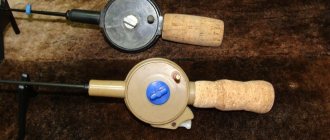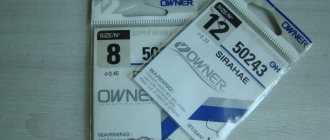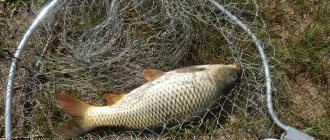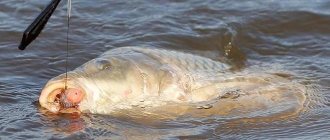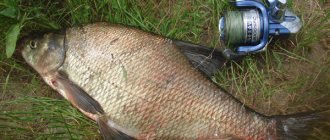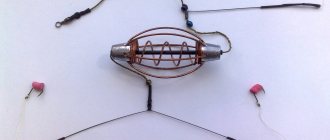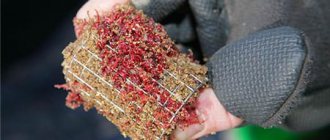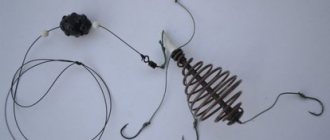In the 70s of the last century, the Englishmen Len Middleton and Kevin Madox, while observing the feeding of carp in an aquarium, noticed that the fish was not interested in the food on a fishing hook, although it picked up the free-floating food without leaving a trace. The conclusion from this experience was obvious - the carp was scared by the fishing line and hook.
Noticing that the fish, when sucking in regular food, is not afraid of foreign objects that fall into its mouth, but simply spits them out, English fishermen hung edible balls on human hair, placing it separately from the hook and called this installation “hair rig.”
The hair rig allowed the bait to become no less attractive than regular food, which means it increased the chance of catching carp to 100%.
Introduction to hair equipment
Hair rig is a branch made of leader material on which the nozzle is placed separately from the open hook. Designed for catching fish that suck food and live in the bottom layer of a reservoir. Hair rigs are also successfully used when catching predatory fish.
The bottom layer contains large specimens of both peaceful and predatory fish. The fittest individuals – smart, cunning, active and cautious – grow to trophy size. It is not easy to deceive and catch such “smart guys”, and hair equipment helps with this.
A rig with a nozzle on the hair, separated from the hook, has a number of advantages over traditional rigging :
- more natural presentation of bait, not loaded with excess weight. The fish calmly sucks in the bait, and the hook that falls after the food is mistaken for a twig that must be spat out;
- increased chance of hooking and self-hooking the lower lip of the fish with minimal harm. When installed correctly, the hook unfolds in the fish’s mouth with the sting down, and when you try to spit out an extra object, the sharp hook pierces the fish’s lower lip;
- ease of installation. Only a short piece of leader material is needed and no additional fishing equipment is required to install the hairline;
- You can use a hard bait , which would otherwise be destroyed when put on the hook. The hard bait retains the smell for a long time, slowly soaks and remains in the water.
- reliable performance of long casts without the fear of dropping the bait from the hook.
Expert opinion
Knipovich Nikolai Mikhailovich
Zoologist, hydrobiologist. I am interested in fishing at a professional level.
Attention! The effectiveness of solid bait in the form of dog and cat food has been experimentally confirmed.
Minor inconveniences associated with the use of hair equipment do not in any way detract from the advantages of its use:
- an open hook catches on obstacles more often;
- There is a higher risk of the hair and the attachment intersecting with other installation elements.
Hair fishing

Fishing with a hair rig is a productive method of fishing for carp, carp, large crucian carp and other underwater inhabitants that feed from the bottom. Shows best results on closed ponds, lakes and quarries; can be used on medium and large rivers with flow.
When fishing with a hair rig, the carp does not see the hook separated from the bait. He confidently sucks it in and then the entire equipment, which is designed so that the single fish, once in the mouth, turns over with the tip down. When hooking, it bites into the lower lip of the fish, causing minimal injury to it.
Choosing a fishing spot
You can fish with a hairline rig at different points in the reservoir, but when choosing a catchable place, it is recommended to be guided by the general principles of searching for a specific type of fish. For example, carp and marketable crucian carp should be looked for in the following areas:
- local grooves and pits;
- pronounced “tables” located in the middle of a monotonous, unremarkable bottom topography;
- separately lying snags and sticks;
- edge close to the shore;
- zones near aquatic vegetation, both coastal and remote from the fisherman.
Recommended reading: Fishing for cicada lures
When fishing on the current, you need to choose holes, dumps, edges, various secluded points - places where the current brings food, which attracts bottom underwater inhabitants.
Adjusting the buoyancy of the nozzles
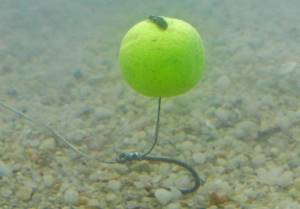
The buoyancy of baits in hair rigs plays an important role. Ideally, the boilie should be positioned at an angle close to 45 degrees to the hook in order to achieve the best results when fishing. When mounting the bait on the hair, you need to take into account the mood of the carp and the fishing conditions.
For example, on muddy muddy soil, when carp take from the bottom, it is necessary to use “snowmen”. This is a combination of floating and sinking baits, when in addition to boiled potatoes or dough, a pop-up boilie is attached. As a result, the equipment does not bury itself in the bottom and is clearly visible to the fish.
On hard ground, when the fish prefers to pick up bait from the bottom, but the angler only has floating boilies, they can be loaded with lead pellets. By selecting its weight, you can make the nozzle hang in the thickness or lie entirely on the ground.
Bite and hook
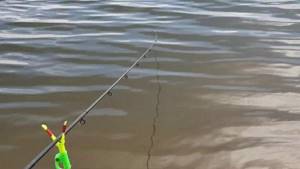
A fish that finds a bait at the bottom sucks it in. Along with it, the hook also gets into the mouth. Feeling resistance or a foreign body in the mouth, it tries to spit out the prey back, but the sting of the single fish, as a rule, digs into the lower jaw.
Based on the characteristics of the equipment, you can advise either not to hook at all, since the carp has already been caught and will be more confidently hooked at the moment of tension of the thread, or to perform a light wrist jerk for reliability. Once you feel the weight hanging on the other end of the line, you can begin to slowly fish.
Hair
Previously, hair was tied to the hook as a separate leader, but today hair is more often used as a continuation of the leader material .
Leading material can be:
- woven materials without braid;
- braided woven materials;
- monofilament, fluorocarbon leader material;
- special leader material for carp.
Depending on the fishing conditions, the angler chooses the leader material independently. So, for catch-and-release fishing, a soft leash made of braided cord is selected, which can cause the least traumatic damage to the fish. If the goal of fishing according to this principle is carp, then it is better to choose a special leash for carp.
A universal leash , which is most often used, is a braided cord without braid. It should not be too thin, otherwise you can cut the fish's lip, but a cord that is too thick will be too noticeable.
Methods for attaching bait to hair
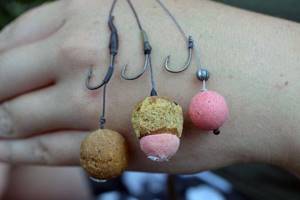
You can attach any bait to the hair – both soft and hard.
Attaching soft bait (boilies, pop-ups, pieces of canned meat, etc.):
- piercing a ball or other soft bait through the center with a needle;
- bringing a leash with a small loop out through the bait;
- inserting a special stopper into the loop (in addition to the purchased stopper, you can use a match, a blade of grass, etc.);
- pulling the leash until the stopper locks.
Expert opinion
Knipovich Nikolai Mikhailovich
Zoologist, hydrobiologist. I am interested in fishing at a professional level.
Important! Small loops are difficult to knit by hand. For knitting loops of different sizes, it is convenient to use loop knitting.
To thread a leash into baits, special needles with a hook are available for sale.
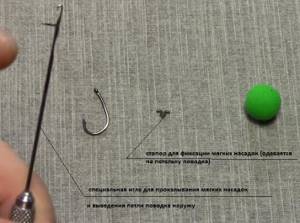
Attaching a solid bait:
- drilling a hole in a solid bait;
- bringing the leash loop out of the bait;
- threading the stopper into the leash loop;
- pulling the leash until the stopper locks.
For drilling a small hole in solid baits, special drills are available in fishing stores.
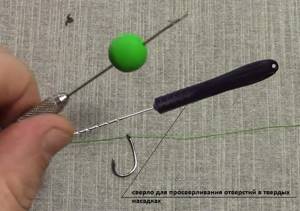
Attaching bait in the form of a bunch or boilie (maggots, pieces of worms, larvae...):
- the hair is threaded into the eye of a sewing needle;
- each element of the bundle is pinned on a needle in turn and pulled onto the hair;
- The hair is tied in a knot, forming a loop in which the bun is located.

Features of catching carp with hair on corn
Since carp is considered an omnivorous fish, in addition to boilies, corn is common as bait. You can purchase a canned product and fix it on your hair. An interesting Chinese bait is artificial corn, which imitates a sweet smell if dipped into an attractant before casting.
Some anglers have adapted to fishing with “drunk” fermented corn. Thanks to its specific smell, it covers a large radius. When corn ferments, it loses its qualities as a rich product, as a result of which the carp remains hungry and continues to peck. This bait is made as follows:
- Fill 1/3 of the container with steamed corn.
- Fill with water 2 times more than the filled product.
- Add yeast or two tablespoons of sugar to speed up the process to a 3 liter container.
- Cover tightly with a lid and leave in a dark place for several days.
The resulting liquid during the fermentation process is perfect for wetting bait or bait. The readiness of the nozzle is determined by a specific pungent odor. Since the fermentation process begins after approximately 3 days, you should wait a week for the product to be completely ready. Drain off some of the water when ready.
Installation of hair equipment
Separate leash
Different attachments require different DIY installation. In this regard, it is convenient to use a separate leash secured above the hook using the loop-to-loop method. In the case of using a bunch of maggots, the second loop for bait is not immediately knitted.
With this installation, it is convenient to put on both baits with pulling the loop inside, and putting on the bait in the form of a bunch of maggots with the subsequent formation of a loop.
A separate leader can simply be fixed on the same axis with the hook and the main leader by tying the leader to the shank of the hook with regular thread.
By loosening the mounting loop, it is easy to remove the separate leash and use another one.
Schmidt method
By fixing the leash with the loop for the attachment with a sliding knot on the main leash, you can adjust the distance from the bend of the hook to the loop.
Hair as an extension of the leash
There are many ways to install hair accessories. This does not affect catchability; the choice of method is up to the fisherman.
Knotless installation
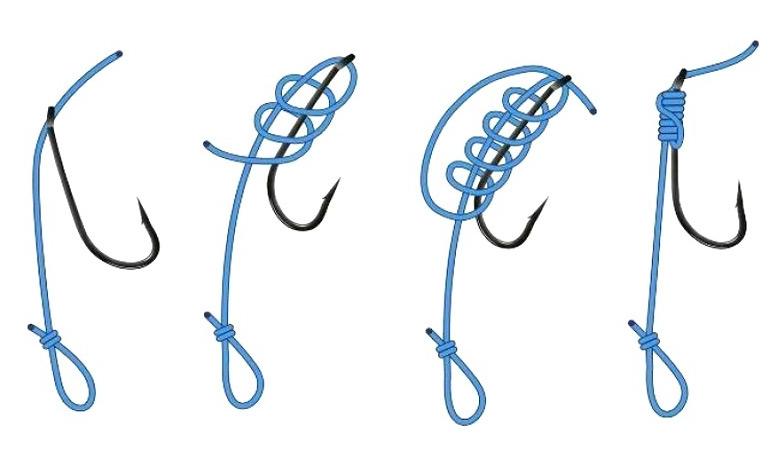
- On a piece of the leash, we make a loop for the nozzle on one side, and on the other end of the leash we put on a heat-shrinkable tube of a suitable diameter (the diameter should be such that the eye of the hook fits freely into the tube) or a piece of thin-walled silicone tube.
- Insert the hook into the tube with the eye facing away from the loop.
- We tighten the leash so that the loop knot is below the bend of the hook.
- We lower the tube down the forend.
- We thread the free end of the leash into the eye of the hook.
- We wrap the shank of the hook tightly, turn to turn, together with a piece of the leash with a loop stretched along the shank. It is enough to make 6-8 revolutions.
- Holding the turns with your fingers, make two or three turns in the opposite direction and pull the end of the leash into the eye of the hook.
- Tighten the knot.
- We put the tube on the knot. The silicone tube is placed on the assembly with an interference fit, and the heat-shrinkable tube, after being installed in place, is heated, tightly enveloping the assembly.
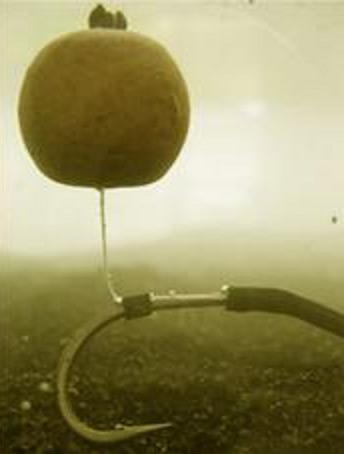
Installation is ready. You can do without a straw, but it is considered safer with one.
Expert opinion
Knipovich Nikolai Mikhailovich
Zoologist, hydrobiologist. I am interested in fishing at a professional level.
Important! In addition to the tube covering the knot, you can use short silicone tubes that fix the hair to the shank of the hook to give the required orientation of the nozzle.
Blowback rig mounting
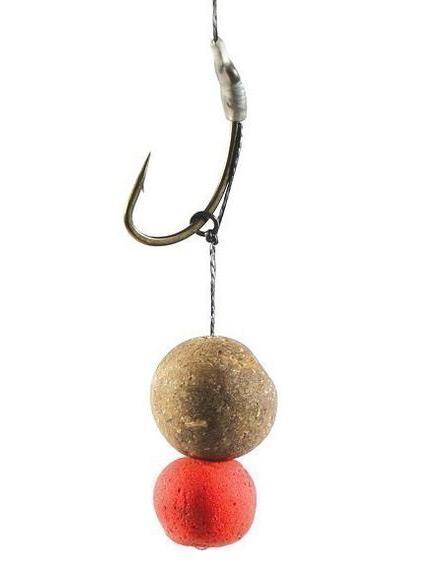
In this option, instead of short silicone tubes that fix the hair with the fore-end, a ring is used that moves freely along the fore-end, which gives the nozzle more degrees of freedom and further reduces the suspiciousness of the fish.
Regular knot
The hook is tied to the leader in the usual traditional way, leaving the end of the leader long enough to form a loop for the bait.
Short tubes or a ring can also be used to secure the hair on the fore-end.
D-rig loop mounting
Mainly used for pop-up nozzles.

The loop formed by a fairly rigid fluorocarbon leader allows the bait to move in different planes, which allows the fish to calmly pull the bait into its mouth from any side.
Knitted from fluorocarbon leader material in several stages:
- A knotless knot is knitted.
- A small ring is put on the hair, the hair is inserted into the eye of the hook, the tip is melted until a ball is formed.
- The other end of the fluorocarbon leader is tied into a loop into which the swivel is threaded.
- We tie a boilie to the ring with a thin fishing line or thread a loop of thin fishing line attached to the ring with a needle through the boilie, thread the stopper into the loop and fix it by pulling the loop.
Rotating circular mounting
The swivel is put on a ring located on the shank of the hook, the hook is connected to the leader through another swivel.
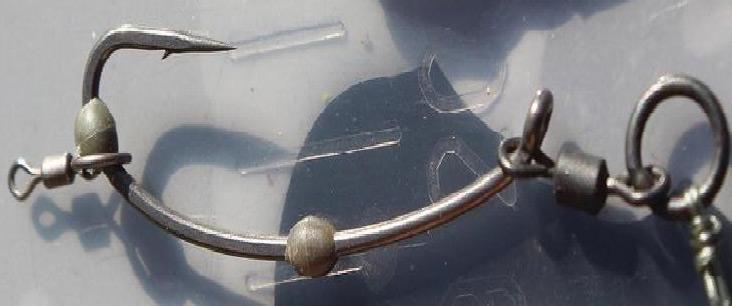
This installation provides the ability to rotate the hook 360 degrees and complete freedom of movement of the nozzle, allowing the fish to approach the nozzle from any side and at any angle and pull it into the mouth.
Clip mounting
To form a voluminous bait that attracts especially large fish, instead of forming a loop at the end of the leash, you can tie a clip. The sharp end of the clip is inserted into the lock, forming an iron loop.
You can place animal, plant, or combined attachments on the clip.
Special tools
CarpZoom and Virux Hair Rigga , are widely used .
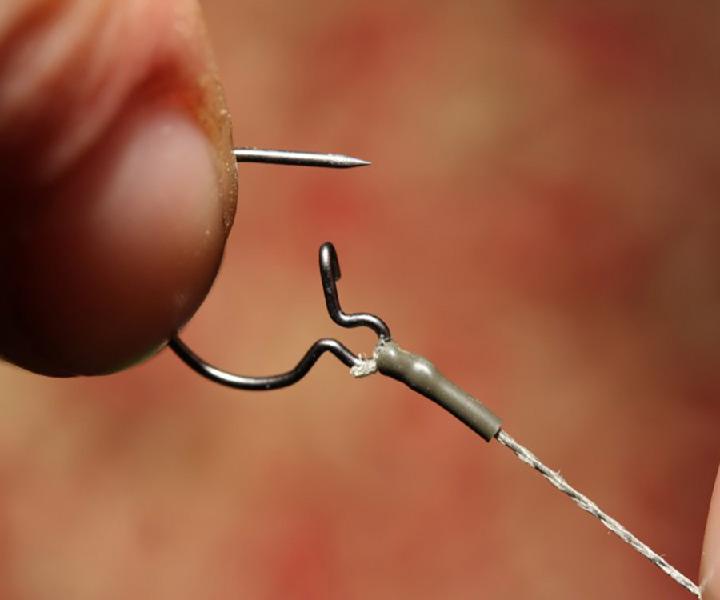
They allow you to precisely adjust the length of the leash with a loop.
Their cost in fishing stores is in the range of 600-800 rubles.
Necessary materials
Making your own hair accessories is quite easy. This will require certain materials:
- Leash material . For production, you do not need to take hair from your head, but you need to select soft material so that the bait looks more natural in a pond. A fishing line made of thick material will not work. You need a soft braided line. Previously, the distance between the bend of the hook and the bait should have been no more than 4 cm. But the optimal distance should be 1 cm. It is necessary to focus on ensuring that the bait moves freely.
- Hook . The hook should be as open as possible and provide a reliable and safe hook. The size of the hook should not depend on the size of the fish, but rather depends on the bait used. The best design for the hook would be if the distance between the beginning and end is equal to half the width of the bait. Example: when using a 10mm boilie, the universal cut will be 4-6mm. Such a hook will not rest against the fish’s lips, but will slip into the mouth for the bait. If boilies of different sizes are used, then the calculation must be made based on the larger size.
- Silicone tube. Its use is not required quite often. On a hook with a small shank, the tube is not used because its ability is assigned to a unit made of a leading substance. Use on hooks with a large shank length is mandatory. The tube helps to correctly guide the hook into the oral cavity at the moment of suction of the nozzle. No tubing requirements apply. There are no leaders among manufacturers either. The tube should be flexible and last for many years.
- Glue . A special glue is used for the equipment. It must be moisture resistant.
- Needle for attachments. Using a needle-broach, the bait is placed on the equipment. This is considered one of the simplest ways. The needle is a "loop lifting needle". They used to be sold in craft stores, but now you can probably find them in the fishing department.
- Anti-twist. To ensure that the tackle does not get tangled when it is thrown, during installation it is necessary to use a leash made of elastic material. If you use a braided leash, you need to install an anti-twist. It is a tube made of plastic.
- Scissors.
- Rubber cone or stopper.
- Boyle is a type of bait. To catch cautious fish, it is necessary to use an attractant, but it quickly dissolves in the reservoir, which leads to the frequency of transfers. The best choice is a boilie with a dense structure. These include soy-based baits and decoys. They dissolve over several days.
Adjusting the degree of buoyancy of nozzles
The optimal location of the nozzle in relation to the hook is considered to be an angle of 45 degrees. It is achieved by adjusting the buoyancy of the nozzle. It is believed that balanced buoyancy is the best option for a bait.
Buoyancy can be changed by forming so-called snowmen, in which pop-ups are combined with sinking nozzles. For example, a ball of dough or boiled potatoes on a marshy bottom will bury itself in the mud and become invisible, but in combination with a pop-up, such a “snowman” will rise above the mud and satisfy fish lovers of potatoes and dough.
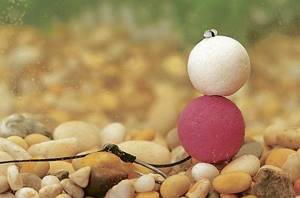
The opposite situation may happen when the pop-up bait needs to be lowered to the bottom, since carp mainly grab food from the bottom. For this purpose, shipping with a lead ball is used - installation of KD-rig .
The pop-up will not float up more than the weight allows it.
Advantages and disadvantages
Like every fishing rig, hair rigs have their pros and cons. Its positive characteristics include:
- High grip and catchability due to self-hooking fish.
- Availability of the materials used; now installation elements are available in almost any fishing store or on a special Internet site.
- Safe to use for fish, cutting is done exclusively on the lower lip. When the hook is removed, the carp is minimally injured and is calmly released back into the pond.
However, some disadvantages of the equipment should be noted:
- difficulty of initial development;
- possible overlaps when using soft leashes.
Requirements for fishing hooks
There are special requirements for hooks for rigs with hair.
Acuity
Both when carp fishing and when fishing with hair for other white fish, the sharpness of the hook must be ideal, otherwise the fish’s self-cutting on the lower lip may not occur.
Size
The hook is selected not according to the size of the fish, which will always be an “X” size, but according to the size of the bait.
The optimal hook for fishing for carp and crucian carp is one whose width (distance from the sting to the shank) is equal to approximately half the diameter of the boilie.
To catch carp in the river, a larger hook is selected; the distance from the forearm to the sting can be 2/3 of the diameter of the boilie.
Form
Long Shank hook – long shank. Such a hook quickly unfolds in the fish’s mouth and therefore has good grip. Optimal for installation with a ring (“Blowback Rig”).
A hook with an eye curved inwards, with a straight short fore-end, the tip parallel to the fore-end for sinking and floating baits when mounting a D-rig.
A hook with a sting curved inwards, a short, straight shank, used in places with numerous accumulations of shells, stones, grass with various attachments, mainly for hard leader materials.
Expert opinion
Knipovich Nikolai Mikhailovich
Zoologist, hydrobiologist. I am interested in fishing at a professional level.
Important! A curved sting does not contribute to 100% self-hooking of the fish, so timely hooking is necessary.
A hook with a short shank in the shape of a banana is used for any bait. The hook has good grip, but can damage the fish's lip if it resists strongly. Effective when installing “KD Rig” with pop-ups.
Barbless hooks are used for sport fishing because they practically do not injure the fish. In the absence of experience, the number of fish coming off such a hook increases.
How to make it yourself for fishing for carp
With all the variety of gear, hair rigs have no equal when fishing for carp. It is popular even when fishing from the shore with a simple float rod. When choosing a place for fishing, it is difficult to ensure that there are no bottom obstacles in order to avoid frequent snags. The ability to predict the behavior of a fish for a successful hook comes with experience and not immediately.
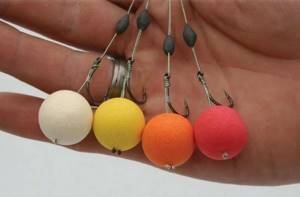
But regardless of external factors, the successful outcome of fishing will be influenced by correctly selected gear: material and length of hair, quality, type and size of the hook. It is better to make the equipment yourself. The effectiveness and choice of elements depend only on your knowledge, experience and instinct.
Important! PVA tapes are afraid of moisture, so work with them only with dry hands, otherwise dissolution will occur before immersion in water!
For basic installation you will need the following components:
- hook;
- main monofilament or fluorocarbon line;
- fluorocarbon fishing line, braid, PVA thread for making hair;
- rings on the forend (rubber cambrics, silicone and heat-shrinkable tubes or soluble PVA tape);
- scissors for cutting off excess fishing line;
- waterproof glue;
- assembly needle for boilies;
- stopper for boilies;
- boyle.
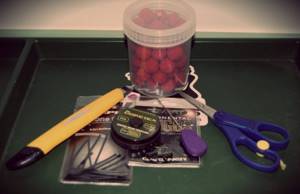
Tools and materials
When choosing a hook and hair material, be guided by the strength and size of the resisting carp, so pay due attention to the quality of each element of carp fishing equipment:
- hook, which is used in assembling this type of equipment, intended for heavy carp or carp, must be of high quality for the success of self-hooking fish. These are found in an assortment of gear from well-known manufacturers; their sharpness is achieved by chemical sharpening. Pay attention to the shape - carp fishermen prefer Use banana-shaped universal hooks with a point long enough to hold large fish. This species rotates well in the carp’s mouth, but its excessive length is fraught with severe damage to the fish, so it is not used in sport fishing, and during normal fishing it leads to the fish being torn off. There are other, no less popular varieties designed for different conditions. For example, a short, straight fore-end and a parallel point are useful for fishing in rivers and crowded reservoirs; hooks, where the fore-end is short, straight with a concave sting, are used in conditions complicated by a littered, rocky bottom with shells; a curved fore-end can be used in clean places, no debris or algae. The effectiveness of hooking increases if there is no barb on the hook;
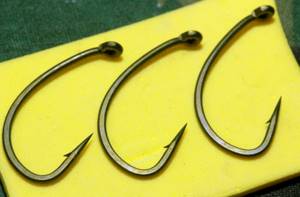
- fishing line - an important component for carp equipment, on which the success of bait delivery, casting distance, and the success of landing fish will depend. Popular types are nylon monofilament and fluorocarbon. Some prefer to use braided cord due to its increased tensile strength, but its low elongation when biting carp weighing over 10 kg leads to frequent breaks. Nylon monofilament line shows better shock absorption capabilities and has increased strength. Disadvantages include the inability to cast long distances and poor sensitivity when transmitting bites. Fluorocarbon types of fishing line are indispensable for catching carp, because they are almost invisible when diving, sink quickly, and do not create windage. Products from well-known companies justify the high price with wear resistance, durability and tear resistance. The cross-sectional diameter of a line that can support carp weighing from 3-4 kg starts from 0.35 mm;
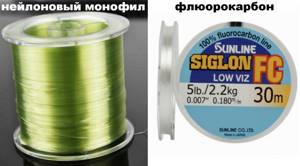
- hair It is preferable to knit from the thinnest but highly durable types of fishing line. There are ready-made gear made from fluorocarbon on sale, but you can make it yourself from braided cord. Both the material and the fastening must have increased reliability, but not rigidity, otherwise the hook will rotate when biting, and hooking will not bring results. As a rule, experienced fishermen do not use nylon monofilament line. Some use thin fluorocarbon and even simple sewing thread. The flexibility and elasticity of the hair rig should be higher than that of the main fishing line. For a high-quality hook, you need to take into account the length of the hair: if it is not large enough, the hook moves towards the upper or corner of the lower lip and can jump out of the mouth.
Important! Fishermen with extensive experience advise that when selecting hair length, proceed from the width of the hook hook-
the size of the leash should exceed it by only 1-2 mm.
The softness of the leader material increases the likelihood of luring wary fish, but also increases the likelihood of entanglement.
To achieve softness of the leash and at the same time eliminate overlapping of the equipment, leadcore is used, i.e., a soft lead core in a nylon braid that merges with the bottom, sinking the equipment. Treatment with a special gel, for example, Kryston Superstiff, will help prevent tangling during casting. With their help, the hair becomes stiff, and the thread or gel will dissolve 40–60 seconds after casting. The size of the nozzle also influences the choice of the optimal rigidity of the leader - the smaller its size, the stiffer the material should be, only then the equipment will not get tangled and will show itself correctly on the bottom. To make hair, you will need up to 20–25 cm of material and an additional 10–15 cm for tying the shell. The length of the finished tackle for fish weighing 6–8 kg usually does not exceed 5 cm;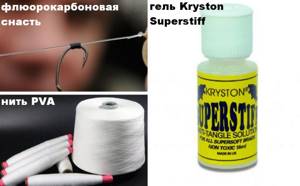
- rings or cambrics on the forend for installation of hair equipment, which must be taken based on the size of the hook and bait. When casting long distances, the load on the rig doubles, so to prevent the bait from coming off, you will need an additional stopper. For ease of use of equipment without replacing and adjusting to different sizes of nozzles, make universal equipment, and when using different nozzles, change only the stopper. Inexperienced fishermen consider it inappropriate to use a cambric in a hair rig, but to avoid the forend getting caught in hair, a tube is necessary. Such installation will sink to the bottom and increase the likelihood of hooking carp. It happens that because of the rubber tube, the carp breaks off when fished. To prevent such cases, use PVA tape. When casting, it will fix the hair in the desired position and dissolve after hitting the bottom.
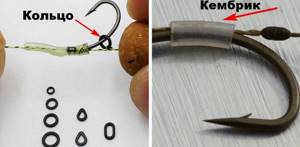
How to knit a snap
There are several ways to install hair rigs, but the finished result looks the same in all cases and does not affect the number of bites.
Find out how to catch carp in the summer.
A common way to collect gear yourself is as follows:
- Cut 25 cm of fishing line or thread prepared for the hair, tie a loop under the stopper at either end of the piece.
- Make a cambric by cutting 2-4 mm from the rubber, plastic or silicone tube that fits tightly around the hook, and put it on the leash. The exact size of the cambric depends on the size of the hook. You can use heat-shrink tubing by heating the piece put on the tackle to the desired degree of compression.
- Place the cambric on the middle of the hook so that it is on the shank opposite the level of the point.
- Pass the fishing line, braid or cord through the cambric and metal eyelet partly without a stopper. The length of the hair is shorter, the greater the amount of fishing line passed through the tube.
- Tie the free end of the fishing line to a hook or to the main leader. For reliability, make several turns around the forend. In this case, the tip should be directed downwards, otherwise the hook should be able to turn over freely - no matter from which side the carp or carp grabs the nozzle, the probability of hooking increases!
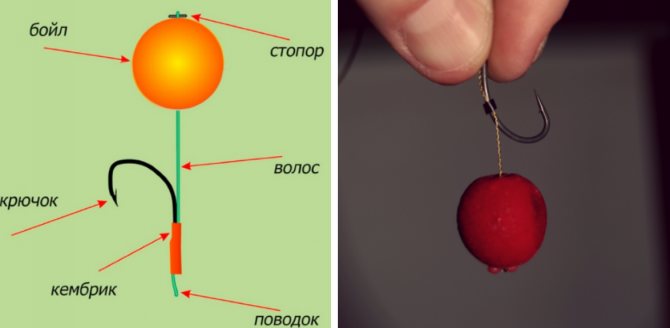
- To prepare the hair, take 25 cm of fluorocarbon, the excess should be trimmed after installation.
- At the end of the hair, tie a loop with a figure eight or other strong knot; it will be needed to attach the stopper that holds the bait.
- An optional but desirable step in preparing the equipment is gluing the connecting elements of the hair to the hook. Use waterproof “Moment” or special types of glue for carp equipment from a fishing store.
- In order to check the effectiveness of the snap you have made, place it on the edge of your palm and pull slightly. The hook should turn with the tip down and stick into the unevenness of the hand. In this case, the equipment works as it should and hooks the fish.
- Many anglers attach equipment for carp species using alternative methods. You can experiment by tying hair of different lengths (0.5–5 cm) to the underhang of the hook, or try to keep the leash from overlapping by threading it through the eye of the hook, using several cambrics or a moving ring distributed on the shank and underhook. They also use the so-called knotless installation, where the hair continues the leash. Professional fishermen do without silicone tubes, as they believe that such clamps worsen fishing performance. In this case, soluble tapes and threads are used.
- Experience will tell you the optimal hair length. It often happens that pre-prepared equipment does not work due to an error made in its length. In this case, re-equipment with an amendment will be required.
Video: hair rigging for carp

How to set bait
Carp is omnivorous and the equipment for it is replete with a variety of baits. But not every one is convenient to combine with hair equipment: it is problematic to use dough and bait such as, for example, worms, maggots, bloodworms, although adherents of such bait manage to tie together 10–15 pieces. in the likeness of boilies.
Common types of bait for large fish are the following:
- corn;
- peas:
- cereal pellets;
- wheat;
- pasta;
- boiled potatoes.
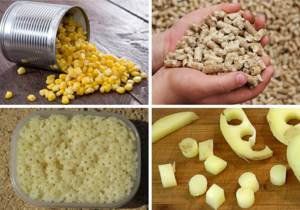
But the best type of modern fishing for large carp by hair is considered to be pop-up boilies, which, due to the hardness of the material, are not suitable for hooking, but stay afloat well and show better results, especially on silty terrain, compared to submersible baits. They do not sink into sticky soil, so they are within reach of the carp. Popularity has increased so much that floating boilies have begun to be used when casting even on hard areas. The bait, which is located above the bottom level, attracts the attention of the carp more strongly.
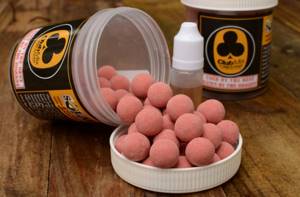
Boilies can be purchased by choosing your favorite among sinking, floating varieties and options with medium submergence. Fishermen prepare them themselves in the form of balls with a diameter of 5–30 mm, consisting of a flour base; they add ground cereals, vegetable oil, eggs, protein in the form of meat and bone meal, aromatic and adhesive substances, for example, gelatin, starch or casein.
Find out which float is best for winter fishing.
All ingredients are boiled, then the mass is formed into balls and painted in the desired color.
After the formation of a durable top layer that will prevent the bait from becoming soggy in the water, it is ready for fishing. When made at home, its buoyancy depends on the heat treatment time - balls that have been boiled longer have an increased density and sink better; these types are suitable for clay and sandy bottoms. Short term treatment will result in high to average boilie buoyancy.
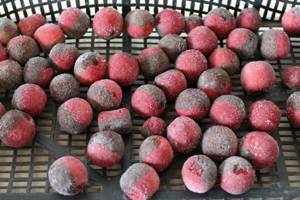
Hard types of bait must be pre-drilled using special drills, which are also presented in the product range. Most boilies are sold with pre-made holes. A mounting needle, similar to the one used to lift the loops when knitting, will help you attach the bait to the hair; this can be easily purchased at tackle sales points.
Did you know? Western European countries cook carp for Christmas, the Poles believe that it gives strength, the Italians consider it food for lovers, and the Chinese see carp as the personification of perseverance and perseverance.
Correct installation of the nozzle must be reliable and effective. When using floating boilies and other types of bait, the D-rig method is suitable , which is based on a hook with a fluorocarbon loop or ring where the bait is attached.
To implement it you need to follow a few simple steps:
- Adjust the buoyancy of the bait by trimming the boilie or foam. For drowning species, it is possible to adjust the degree of immersion by inserting a piece of cork or foam inside.
- Using a special needle, carefully make a hole in the bait.
- Place a leash there that comes from the hook.
- Pull the hair through the nozzle.
- The bait needs to be fixed, this can be done with dental floss or thin fishing line, and then tied to a loop.
- Install the stopper and secure it with a loop, placing the bait as close as possible, according to the fishing rule that the boilie should “lick” the hook.
- For sinking bait, the hair must be made longer (at least 10–20 mm) than for floating bait.
Video: installation of the nozzle
Fishing for predatory fish using hair rigs
For catching predators such as pike and pike perch, the same design of hair equipment is used as for peaceful fish, only for pike it is advisable to use live bait, since it reacts to movement, and for pike perch and perch, which react more to smell, fresh pieces of fish are used without head and tail.
To break through the hard mouth of pike perch and pike, you need sharp hooks, preferably chemically sharpened.
The leash for pike is an iron string with a tee and a separate leash made of braided cord with a hook for live bait.
Leader for cautious pike perch that do not have sharp teeth - fluorocarbon leader material with a piece of fish and a single hook.
The hair rig was a revolutionary step in fishing not only for carp and other peaceful fish, but also introduced variety into the rig for catching predatory fish, significantly increasing catchability in both cases.
What is hair?
The idea of the rig is to separate the bait and hook a short distance. With this arrangement of elements, the carp does not notice the foreign metal element when biting and boldly swallows the tasty ball.
After getting into the fish's mouth, the hook and a thin leash, hair, begin to interfere with the fish, the carp tries to spit them out, while self-hooking occurs on the lower lip thanks to the use of a rather heavy sinker.
Thus, we can point out several advantages that hair rigging for carp undoubtedly has:
- invisibility of the hook behind a large bait;
- when swallowed, the fish does not prick itself on the tip of the hook;
- when trying to get rid of the hook, the fish hooks itself.
This type of installation is used not only for carp gear, but is also used for the feeder, if hair equipment is used for bream or other “white” fish.
Rod and tackle for carp fishing for corn
Carp are caught both with carp feeder rigs and with a float. Let's look at the rod and gear for both cases.
Rod
Fly rod or Bolognese rod – it doesn’t matter. The length and the following elements are important:
- The length of the rod is from 3.9 to 4.8-5 meters. With rods shorter than 3.9 m in length it will be difficult to tire the carp when fishing, but with a long one it is simply inconvenient.
- Reel seat . Must be as reliable as possible. When fishing for a large carp, you must not allow the reel to simply fly out.
- Passing rings . It is best if the rings are titanium. It is also desirable that the rings be coated with silicon carbide (SiC) or aluminum oxide and titanium nitride, which will protect the cord from chafing.
- The action is medium-fast, medium.
- Test from 80 grams for a feeder and from 30 grams for float fishing of individuals from 1.2 kg . When catching trophy specimens - from 120 grams for a feeder.
A rod that is too rigid will lead to frequent fish escapes, the tackle will tear the soft tissues of the carp and escapes will be guaranteed.
A more detailed guide to choosing a feeder rod.
Coil
In order not to get involved in the debate about reel models, we will indicate the minimum requirements for carp fishing:
- Type . Inertialess.
- The spool size is from 4000. It is better from 5000, but 4000 may well be enough for small carp.
- Spool material . Anything other than plastic.
- Number of bearings . Not so important, 4 is enough.
- Bayrunner . Presence in carp fishing is mandatory.
- Friction clutch . Preferably the rear one.
- Gear ratio . About 4.6:1, 4.9:1.
Quality, time-tested manufacturers: Daiwa, Mikado, Shimano.
fishing line
The main requirement for fishing line, in addition to the quality of the material and thickness, is color .
Carp are very sensitive to color recognition, and are very suspicious, so the fishing line should have a color as close as possible to the color of the water, or be transparent. Thickness. For braided cord from 0.25 mm , for monofilament from 0.3 mm . There is no universal thickness; you will have to choose based on information about the size of the carp present in the reservoir.
Material . Braided or monofilament. Monofilament line better absorbs the jerks of large fish and has greater elongation, however, it is less durable and the minimum thickness for monofilament is 0.3 mm for carp fishing. Braid is stronger and thinner, but does not stretch well and absorbs shocks, risking the tackle breaking. Our choice is thick monofilament.
Extensibility. The minimum stretchability of the fishing line when carp fishing is 5% , the maximum is 15% .
Leashes . For leashes, the material used is fluorocarbon . Initial thickness from 0.28 mm .
Hook
To directly attach corn to a hook, hooks with the most curved tip and neck and an extremely sharp barb are used. This is necessary so that the carp does not pull the bait and go home without biting. Also in float fishing, the length of the forend is important if you want to place several grains of corn or make a sandwich (alternating corn and, for example, a worm).
For hair rigs, the connecting part of the hook and line is important, and the presence of an eye is mandatory. Short sting. Hook sizes according to the international (European, EU) classification are from No. 2 to No. 6 .
Sinkers and float
For fishing with a float rod, a 12-gram float . It should be shaped like a long antenna, clearly marked for good visibility when biting.
The load consists of a main sinker and several pellets (secondary pellets). The main weight is attached directly under the float.
Some people recommend coloring sinkers in muddy and earthy colors, but testing has shown that there is no correlation between sinker color and bite frequency.
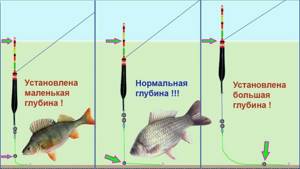
Feeders
The feeder is selected based on the fishing conditions.
For fishing on rivers with current. feeders are used - cages . The material of the feeder is not as important as its loading. In weak currents, feeders from 40 grams are used, in strong currents - from 80.
For fishing in lakes and ponds . The most popular feeders for carp are flat and spring. Open, the bait is evenly distributed along the bottom, creating a fragrant cloud of dust that cannot help but attract carp.
Remember! When fishing on a muddy bottom, do not use heavy feeders, they will simply get bogged down in the mud and the area will be very poorly fed.
Advantages and disadvantages of hair rigs when fishing for carp
The first step is to become better acquainted with this equipment option. Find out all the pros and cons so that you don’t get an unpleasant surprise while fishing. Let's start with the disadvantages of hair equipment. Essentially there are two of them:
- Predisposition to getting caught on stones, algae, snags and grass. After all, the hook remains completely uncovered. Therefore, it is necessary to fish especially carefully in overgrown water areas.
- There is an increased risk of overlapping and tangling, because from the bare hook there is another, albeit short, leash.
That's probably all. Hair equipment has no other disadvantages. But there are many more advantages:
- The most reliable fixation of bait (boilies, pellets, corn), allowing you to make long casts without fear of losing the bait.
- A more natural presentation of the bait, which is not loaded with a hook. Due to this, the number of bites increases.
- Minimal chances of harming the fish itself (this is important, because most carp fishermen fish using the catch-and-release principle), since the sting mainly pierces the lower lip. Thus, the carp is not injured, and the hook is easily pulled out of its mouth.
- Higher number of successful hooks compared to other rig options. Often the carp even hooks itself, trying to spit out the hook.
- Easy to install. This is another advantage of the hair rig, because it does not require expensive materials, and every angler can make it.
Step-by-step process of knitting rigs
We will make a leash without using heat shrink tubing. Some fish only with it, while others, on the contrary, are convinced that it is useless.
Let's consider the option of producing two types of leashes. They are basic and are used both on bottom and floating boilies.
We will use braided material. The production of a leash from wicker material is carried out in a similar way.
- Leash for bottom boilies. We take a certain amount of driving material and remove the braid from the required section. The distance can be from 9 to 14 cm, it depends on the dimensions of the hook. It also plays a role how much distance you want to leave as a free edge. Basically it is 3 cm, but you can do more if you wish. It is necessary for naturalness. In this case, use hook No. 6 and strip 11 cm of braid. It can be easily dismantled when using a tool.
- After dismantling part of the braid, you need to tie a small loop on it using a figure eight knot.
We install a stopper for the boilie in the resulting loop; it will not allow it to slide along the hair. Use a boilie needle to tighten the knot. Tightening must be done tightly, but force should not be used. - It is necessary to cut off a piece of silicone tube.
- We cut the required piece of leader material. We take an increase in size. If you need a piece of 15 cm, measure the distance from the leash, which is in the braid, to the free edge, then cut off 20 cm. An additional piece will be needed to tie a loop, to fasten the leash to the swivel. It is necessary to put the tube on the leash where the braid is located.
- We insert the hook through the silicone tube. We pass the hook through the tube so that it is on the hook. Then we pass the tip of the leash into the eye of the hook, from the outside to the sting.
- We put the boilie on the boilie needle.
- We use a needle to hook a loop on the leash and pull the boilie from the needle onto the hair.
- Using the stopper located in the loop, we fix the boilie.
- We estimate the required hair length. This length depends on the boilie, and there are no optimal options. The hair should not be short, otherwise it will be impossible to make a cut.
- It is possible to change the length of the hair if the serifs are incorrect.
- If the hair distance is selected, then the next step is to tie the hook.
- We check the leash for a notch. To do this, they need to swipe across the palm of their hand. If the leash is made, it’s true, then if the hand is uneven, it will turn over and get caught.
- At the end of the leash you need to tie a knot in the form of a double figure eight. You need to put a shank on top, it will cover the junction of the loop with the swivel.
The leash is ready.
